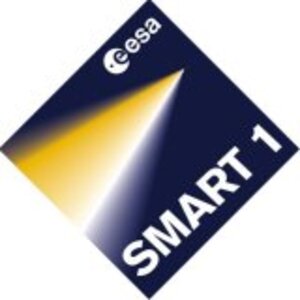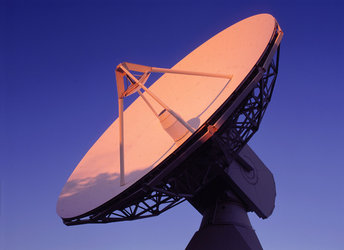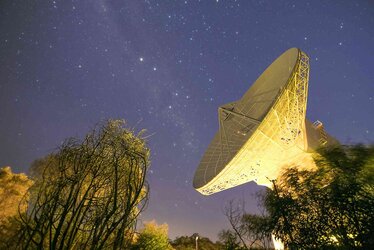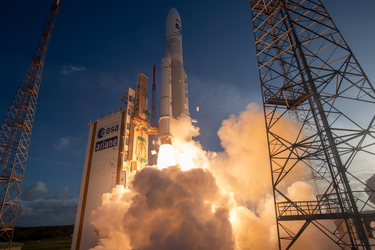SMART-1 operations
| ROLE | Testing solar-electric propulsion and other deep-space technologies, and validating a new set of miniaturised instruments aimed at lunar scientific investigations. |
| LAUNCH DATE | 27 Sept 2003 |
| LAUNCHER/LOCATION | Kourou, French Guiana on a shared Ariane-5 ride to geostationary-transfer orbit (GTO). |
| LAUNCH MASS | 370 kg |
| ORBIT | 16-month transfer orbit from GTO to lunar orbit insertion, then polar elliptical operational orbit, ranging from 300 to 3000 kilometres in altitude above the Moon. |
|
NOMINAL MISSION |
Completed on 3 Sept 2006 |
| + ESA’s first mission to use ion propulsion for interplanetary navigation + | |
The mission

Smart-1 was ESA’s first Moon mission. In addition to investigating the Moon and studying chemical elements in the lunar surface, the spacecraft successfully demonstrated the use of advanced ion propulsion for navigation and a number of innovative mission control techniques. The mission was technically and scientifically a success, helping ensure Europe’s technology competence in this promising technology and in Lunar exploration. Electric-ion propulsion sent SMART-1 to the Moon on just 82 kilograms of Xenon fuel.
The Flight Control Team

Octavio Camino was Spacecraft Operations Manager (SOM) for SMART-1. Camino comes from Las Palmas de Gran Canaria, in Spain, and joined ESA in 1992 after obtaining a master's degree in telecommunications. He describes the SMART-1 flight control team as "motivated, innovative and flexible," and pointed to the "ever-changing and challenging environment of space operations" as one of the most enjoyable aspects of his job.
After the launch, the SMART-1 Flight Control Team (FCT) was reduced to just a handful of engineers, much smaller than a traditional FCT. This necessitated the use of on-board autonomy and innovative mission control techniques.
The SMART-1 mission ended on 3 September 2006 when it underwent a controlled impact with the Moon, an event that itself provided additional opportunities for ground-based observers to learn about the Moon's surface. Camino was reassigned as SOM for Venus Express in 2006.
Mission operations overview

SMART-1 was launched 27 September 2003 together with Insat3E (by ISRO) and eBird 1(by Eutelsat), by an Ariane 5 launcher from Kourou, French Guiana.
It was then released into a Geostationary Earth Orbit of 7029 x 42263 km. After the Launch and Early Orbit Phase (LEOP) was complete, it used its solar-electric propulsion to gradually spiral out to the Moon over a period of thirteen months.
The target orbit after reaching the Moon was polar with the pericentre (point of closest approach) close to the South Pole between 300 and 450 km, with about 3000 km for the apocentre (point of farthest separation). During the transfer phase, before reaching the Moon, the spacecraft thrusting profile allowed extended periods for cruise science, including mapping the plasma-density distribution around Earth. The ion thruster was used to spiral out of the transfer orbit and for all orbit manoeuvres including lunar capture and descent.
By accelerating SMART-1 at 0.2 millimetres per second², an incredibly gentle thrust could in theory fling the spacecraft right out of the Solar System, if sustained for long enough. In practice, SMART-1 used its ion engine intermittently over 16 months, fighting against Earth’s gravity, to put itself into orbit around the Moon.
SMART-1 also tested future deep-space communication techniques for spacecraft, techniques to achieve autonomous spacecraft navigation, and miniaturised scientific instruments operating in visible, infrared and X-ray wave lengths.
As SMART-1 gained distance from the Earth, its speed dropped. At
At a crucial stage in the journey, called lunar capture, SMART-1 passed though an invisible ‘doorway’ in space at Lagrange Point No.1, or L1. As first noted by the mathematician Joseph-Louis Lagrange in 1772, the gravitational effects of the Moon and the Earth are in balance at L1,
Beyond L1, SMART-1 flew over the lunar North Pole, aiming at a point of closest approach above the South Pole, so achieving a wide polar orbit around the Moon. During the weeks following its capture by the Moon, SMART-1’s ion engine gradually reduced the size and duration of its orbit, thus improving the view of the lunar surface for its science instruments.
The ground stations

Initially, SMART-1 used three stations during LEOP (Launch and Early Orbit Phase): ESA’s ESTRACK stations at Kourou (15m), Villafranca (VIL-2, 15m) and Perth (15m). Later, ESA’s Transportable station (5.5 m) and the VIL-1 (15m) antennas also at Villafranca, the New Norcia station (35m) in Western Australia as well as Weilheim (30m) in Germany were used.
The platform and payload
The Spacecraft Design
SMART-1 was designed for good operability. Two important aspects of the SMART-1 design were its robustness and safe-mode design, enabling it to recover gracefully from any misconfiguration.
All basic units related to spacecraft safety were provided with good redundancy:
- Telemetry and telecommanding systems and receivers were ‘hot’ redundant
- Redundant buses (CAN) for the Platform and Payload
- Two main controllers including memory were provided in cold redundancy
- Electric propulsion and related units with limited redundancy
- Payload units had no redundancy.
The SMART-1 spacecraft spanned 14 metres with its solar panels extended, but otherwise everything for propulsion, communications, housekeeping and instrumentation fit into a cube just 1 m across.
Propulsion by an ion engine was not the only innovative technology on SMART-1. Its solar panels used an advanced type of gallium-arsenide solar cells in preference to the traditional silicon cells. And the mission tested new communication and navigational techniques.
Operating in the near vacuum of space, ion engines shoot out a propellant gas much faster than the jet of a chemical rocket. They deliver about ten times as much thrust per kilo of propellant used. The ions that give the engine its name are charged atoms, accelerated by an electric potential, If the power comes from the spacecraft’s solar panels, as it did for SMART-1, the techniques is called ‘solar-electric propulsion’.
Ion engines work their magic in a leisurely way. As solar panels of a normal size supply only a few kilowatts of power, a solar-powered ion engine cannot compete with the whoosh of a chemical rocket. But a typical chemical rocket burns for only a few minutes. An ion engine can go on pushing gently for months or even years – for as long as the Sun shines and the small supply of propellant lasts.
The type of ion engine chosen for SMART-1 makes clever use of an effect discovered by the American physicist E.H. Hall in 1879, whereby a current flowing across a magnetic field creates an electric field directed sideways to the current. This is used to accelerate ions of xenon. A gassy element with atoms about 131 times heavier than hydrogen atoms, xenon is chemically inert.
Drawing electric power of 1350 watts from SMART-1’s solar panels, the ion engine generates a thrust of 0.07 Newton. That is equivalent to the weight of a postcard.
Out of a total mass at launch of 370 kilograms, the payload available for a dozen technological and scientific investigations was 19 kilograms. Like other components of the spacecraft, the scientific instruments used state-of-the art concepts and methods of miniaturization to save space and economise on mass. For example the X-ray telescope D-CIXS made a cube just 15 centimetres wide and weighed less than 5 kilograms.
|
Instrument |
Name |
| EPDP | Monitored how the ion engine performed |
| SPEDE | An electrical experiment observed the steam of charged particles and associated magnetic fields coming from the Sun |
| KaTE | Microwave system – demonstrated the next generation of Ka band radio links between the Earth and far-flung spacecraft |
| RSIS | Radio experiment – demonstrated a new way of gauging the rotations of planets and their moons |
| Laser Link | Communications experiment |
| OBAN | Evaluated a computer technique for on-board autonomous navigation |
| AMIE | An ultra-compact electronic camera: surveyed the terrain of the moon in near-infrared light |
| SIR | An infrared spectrometer: charted the Moon’s minerals |
| D-CIXS | An X-ray telescope: identified key chemical elements in the lunar surface |















 Germany
Germany
 Austria
Austria
 Belgium
Belgium
 Denmark
Denmark
 Spain
Spain
 Estonia
Estonia
 Finland
Finland
 France
France
 Greece
Greece
 Hungary
Hungary
 Ireland
Ireland
 Italy
Italy
 Luxembourg
Luxembourg
 Norway
Norway
 The Netherlands
The Netherlands
 Poland
Poland
 Portugal
Portugal
 Czechia
Czechia
 Romania
Romania
 United Kingdom
United Kingdom
 Slovenia
Slovenia
 Sweden
Sweden
 Switzerland
Switzerland
































